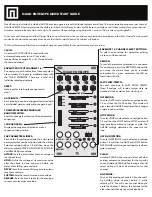
Patient Monitor User Manual Intended Use and Safety Guidance
- 2 -
1.2 Safety Guidance
Federal (U.S.) law restricts this device to sale by or on the order of a physician.
WARNING
1
To ensure that the monitor works properly, please read the user manual and follow
the steps before using the monitor.
2
Before using the device, the equipment, patient cable and electrodes etc. should be
checked. Replacement should be taken if there is any evident defect or signs of aging
which may impair the safety or performance.
3
Medical technical equipment such as these monitor/monitoring systems must only be
used by persons who have received adequate training in the use of such equipment
and who are capable of applying it properly.
4
EXPLOSION HAZARD-Do not use the device in a flammable atmosphere where
concentrations of flammable anesthetics or other materials may occur.
5
SHOCK HAZARD-To avoid the RISK of electric shock, this equipment must only be
connected to a SUPPLY MAINS with protective earth. Never adapt the three-prong
plug from the monitor to fit a two-slot outlet.
6
Do not come into contact with the patient, table, or the monitor during defibrillation.
7
The simultaneous use of cardiac pacemaker and other patient-connected equipment
may cause safety hazard.
8
Magnetic and electrical fields are capable of interfering with the proper performance
of the device. For this reason make sure that all external devices operated in the
vicinity of the monitor comply with the relevant EMC requirements. X-ray equipment
or MRI devices are a possible source of interference as they may emit higher levels of
electromagnetic radiation.
9
Extreme care must be exercised when applying medical electrical equipment. Many
parts of the human/machine circuit are conductive, such as the patient, connectors,
electrodes, transducers. It is very important that these conductive parts do not come
into contact with other grounded, conductive parts when connected to the isolated
patient input of the device. Such contact would bridge the patient's isolation and
cancel the protection provided by the isolated input. In particular, there must be no
contact of the neutral electrode and ground.
10
Route all cables carefully to avoid possible entanglement, apnea, or electrical
interference. For the device mounted over the patient, sufficient precautionary
measures should be taken to prevent it from falling on the patient.
11
Devices connecting with monitor should be equipotential.
12
If the protective grounding (protective earth) system is doubtful, the monitor must be
supplied by internal power only.















































